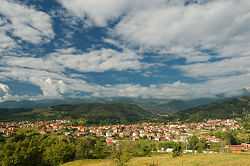Breznitsa
| Breznitsa Брезница | |
|---|---|
| Village | |
 | |
 Breznitsa | |
| Coordinates: 41°40′N 23°40′E / 41.667°N 23.667°ECoordinates: 41°40′N 23°40′E / 41.667°N 23.667°E | |
| Country |
|
| Province | Blagoevgrad Province |
| Municipality | Gotse Delchev |
| Government | |
| • Mayor | Isa Sakali (DPS) |
| Area | |
| • Total | 81.815 km2 (31.589 sq mi) |
| Elevation | 715 m (2,346 ft) |
| Population (15-12-2011 [1]) | |
| • Total | 3,389 |
| GRAO | |
| Time zone | EET (UTC+2) |
| • Summer (DST) | EEST (UTC+3) |
| Postal Code | 2972 |
| Area code(s) | 07529 |
Breznitsa is a village in Gotse Delchev Municipality, in Blagoevgrad Province, Bulgaria. It is located 12 kilometers northwest of Gotse Delchev and 61 kilometers southeast of Blagoevgrad in the Pirin mountain. The Tufcha river is flowing by the village. A municipal asphalt road connects Breznitsa with the second class road Razlog - Gotse Delchev.
History
The village is mentioned for first time in the Ottoman documents in 1464-1465 as a village with 78 non-Muslim households, 8 not-married people and 2 widows.[2] Between 1498 and 1502 in another document were counted 6 Muslim households and 180 non-Muslim ones,1 non-married Muslim, 22 not-married non-Mulims and 12 widows.[3] The growth of the population continued until 1530, when the population slightly decreased. The village became a center of a "zimaet"- a small feudal property, together with Kornitsa and Lazhnitsa. In 1689 the village was plundered. In 1723 Breznitsa was described as "a village with a mosque". In 1873 year the village was described as one with 80 households of 230 pomak people.[4] In 1899 were counted 821 inhabitants.[5] According to Vasil Kanchov in 1900 year counted 850 Bulgarian-Muslim people, living in 191 houses.[6] After 1912, when the village became part of Bulgaria some Christian people from other villages, that were left outside Bulgaria came there. Remains of an Ancient and Medieval fortress are found 2 kilometers north of the village.
Religion and ethnicity
Nowadays Breznitsa is a mostly Muslim village. There are a mosque and a church in the village. After the Balkan war in 1912 in the newly incorporated pomak villages the local people were forced to accept the Christianity by the Bulgarian church and paramilitary formations of the Internal Macedonian Revolutionary Organization (IMRO).[7][8] The process of converting did not gained results and after the actions people returned to the Islam. There were several attempts of renaming - changing the Muslim names of the pomaks with non-Muslim. The most controversial one was in the end of 1972 and the first three months of 1973 and its culmination was on March 28, 1973, when military and militia isolated the three villages Lazhnitsa, Kornitsa and Breznitsa and a serious unrest in Kornitsa led to casualties among the local people and the military both.
Economy
The most important source of income for the people is the tobacco growing, but in the recent years the tobacco industry is suffering from the restrictions of smoking in Europe. People also grow potatoes and berries. Many women from the village are working in small tailoring workshops. Some young people go to search for work in the bigger towns and abroad.
Health care and education
The health care in the village is provided by a general practitioner and two dentists. A secondary school "Sv Sv Kiril i Metodii" is gathering the pupils from I to XII grade. The school is founded in 1913 year and is officially opened in 1920. In 1935 a new school building is opened. In 1966 year the first wing of the present school building is finished and in 1988 is build the second one. In 1999 the school is transformed from primary to a secondary school. There is a kindergarten with a nursery group and a cultural club, opened in 1940 year.
Tourism
The situation of the village in the low parts of the slopes of the Pirin mountain is favorable for start point for hiking and walking routs along the Tufcha river towards the three cirque lakes "Breznishki ezera" and to the alpine parts of Pirin. There are two small caves near the village.
References
- ↑
- ↑ Бошков, Ванчо (1978). Турски документи за исотијта на македонскиот народ, серия 2, том 4. Скопје: Архива на Македонија. p. 46. OCLC 165435293.
- ↑ Димитров, Страшимир (1965). "Откъси от регистър за ленни владения в Западните Родопи и Серско". Родопски сборник 1: 313–314. OCLC 402561706.
- ↑ Македония и Одринско. Статистика на населението от 1873 г. (in български, френски, английски, руски) (II издание ed.). София: Македонски научен институт. 1995 [1878]. pp. 128–129.
- ↑ Template:Цитат уеб
- ↑ Кънчов, Васил (1996) [1900]. "Неврокопска Каза". Македония. Етнография и статистика (II издание ed.). София: Проф. М. Дринов. p. 194.
- ↑ ТДА-Благоевград, Ф. 198 К, оп. 1, а.е. 9, л. 15б
- ↑ ТДА-Благоевград, Ф. 198 К, оп. 1, а.е. 9, л. 57-58
| ||||||||||||||||||||||||||